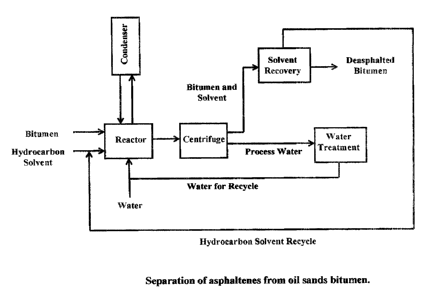Note: Descriptions are shown in the official language in which they were submitted.
CA 02428995 2003-05-16
Sepa:~atiodd ofAsp6dallenes frodn Bltl11926rr urru rrwr.-y vrre uorrrg a1
/~BfQr."lldjt ~"atldlJ~St l'13~e
~~'S~r~Ip~l01'H
Eacliaround of the Invention
The fraction of petroleum (crude oil, heavy oil or bitumen) which is insoluble
in rz-
pentane or n-heptane and soluble in benzene is defined as asphaltenes.
Asphaltencs ar;,
the highest molecular weight fraction of the oil sands bitumen, with an
average molecular
weight of about 3,600. The average molecular weight of the asphaltenes could
lye
different for different hydrocarbons.
Athabasca oil sands bitumen of Alberta, Canada contains about 14 % to 22 ~ o
asphaltenes. Athabasca oil sands asphaltenes are composed' of about 79.9
°~o carbon (C),
8.3 % hydrogen (H), 1.2 % nitrogen (N), 7.6 % sulfur {S), 3.2 % oxygen (O),
which
corresponds to atomic H/C ratio of 1.24. Asphaltene molecules are known as
coke
precursors, because of their tendency to produce poke by thermal cracking
reaction upon
heating.
Presence of asphaltenes molecules, as an example, in oil sands bitumen creates
problems
during the pipe-line transportation of bitumen. In pipe-line transportation.
addition o I'
light hydrocarbons is generally used to reduce the viscosity of bitumen.
Separation and
precipitation of asphaltenes in the bitumen light hydrocarbon mixture in the
pipe-l.i.n;.
causes plugging problems. A mild thermal or catalytic cracking, which i.s also
called
visbreaking, as an example, may be used to reduce oil sands bitumen viscosit~r
Asphaltenes present in mildly cracked bitumen may also create problems during
the pipe-
line transportation because of the separation and the precipitation of
asphaltenes in tile:
pipe-line.
Presence of asphaltenes, as an example, in bitumen also creates problems
during the
upgrading of bitumen to synthetic crude oil, because of the tendency of
asphaltenes t<>
produce coke and to poison the active sites of the hydrotreating and/or
hydrocrackir~:~
catalysts. As a result, a primary upgrading process, also called coking, is
generally used
to eliminate the asphaltenes. Using the coking process, as an example, bitumen
is
converted into petroleum coke, coker gas oil and light hydrocarbon gases by
thf:rm
cracking reactions.
Separation of asphaltenes, as an example, from oil sands bitumen, heavy oils
or heavy
end of the refinery products is applied in the oil industry. Separation of
asphaltenes is
CA 02428995 2003-05-16
Separation ofAsphaltenes from Bitumen and Heavy Oils using a Metal Salt
Catalyst i'ccge s
generally achieved by diluting the asphaltene containing hydrocarbons by
ligL,t
hydrocarbons, such as pentene or hexane. Because of the solubility
limitations, i:lv
asphaltenes are separated from the solution. Centrifuge is a commonly used
practice tv-
precipitate already separated asphaltenes.
The Present Invention
In the present invention separation of asphaltenes is enhanced by increasing
tr,a
molecular weight of the asphaltenes by intra molecular condensation and
flocculation cwf
the asphaltene molecules using the Friedel-Crafts type alkylation reactions.
Thes;.
reactions are promoted by the catalytic effect of metal salts, such as but not
limit;,d ia:
aluminum chloride (AlCl3), zinc chloride (ZnCl2) and ferric chloride (FeC'l3).
~(Jsing th:::
the Friedel-Crafts type alkylation reactions, asphaltene molecules are
combined together
between the aromatic and aliphatic functional groups as depicted, but not
limited to b5,~
tl~e following chemical reaction:
<4sphaltenel - C6 H5 + Asphaltene2 - R - A~ Asphaltene, - C6 H4 - R -
.4.~phw'te~ez
where, Asphaltenel and Asphaltene2 are the two different asphlatene molecules
containing aromatic (C6H5) and aliphatic (R) functional groups, respectively.
This
reaction is catalyzed by the metal salts such as aluminum chloride (AlCl3),
zinc chloriC?c
(ZnCl2) and ferric chloride (FeCl3).
The extents of the Friedel-Crafts type alkylation reactions would be
controlled by trAe
reactor operating conditions, composition of the reacting system, catalyst,
«~ater, dilueoT;t
hydrocarbons, solids and concentration of the asphaltenes, temperature,
an~~bility of tr s
asphaltenes, mixing, etc. As the extents of the Friedel-Crafts type alkylation
reactions
increase by eliminating the rate controlling steps and providing the
sufficient operatin?
conditions, the magnitude of the intra molecular condensation and
flc~ccul~tior:: c:1'
asphaltenes also increases, which results in a sharp reduction in the
solubi.li'.y c~f
asphaltenes, and eventually the separation and the precipitation of the
aspha.ltenes.
Effects of different metal salts on the separation of asphaltenes are
presented in .~ i.g~re
and Figure 4. Effect of the metal salts on the separation of asphaltenes would
be ~:
function of the nature of the asphaltenes containing mixture.
The present invention could find applications in the separation of
aspl?.altenes fror:-~.
asphaltenes containing mixtures, such as but not limited to oil sands bitumen
and water
slurry based oil sands extraction froth.
Smnr~nary of the Invention
A primary objective of the present invention is to provide an improved process
or rnetho_i
for the separation of asphaltenes. The present invention is based on the intra
malecul
condensation between the asphaltene molecules similar to the Friedel-Crafts
type;
alkylation reactions to condensate and flocculate a.sphaltenes for their rapid
separatio-~-~
. . . .. ..W..: r . ", ... . ,.,. , . -.,: . . . .. ~w . ..
CA 02428995 2003-05-16
Separation of Asphaltenes from Bitumen and Heavy Oils using a Metal Salt
Catalyst .t'c~ge
and precipitation. The present invention uses the catalytic effect of metal
salts, su~;,i~ u,~
but not limited to aluminum chloride (AlCl3), zinc chloride (ZnCl2) and ferric
chloric~",
(FeCl3) to promote the Friedel-Crafts type alkylation reactions.
The present invention could be applied commercially for the separation of
aspl~alter;e
from asphaltenes containing hydrocarbon mixtures, including the mixtures
containir.~=
water and solids, such as sand, silt and clay.
ether prior art considers thickening apparatus of interest hereto includes
~J.~, f'at. I~(o;s.
4,846,957; 4,124,486; 4,865,741; 4,155,833 and Canadian Pat. No:>.
1,330,06.'?;
1,192,520; 2,063,101; 1,177,770; 1,100,080; 1,256,392; 1.207.,699; 1,:~90,i71;
2,277,052;
